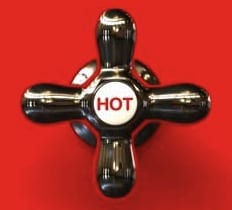Heat storage and heat recovery from phase change material (PCM) systems could make hot water services a lot more efficient and that’s important – if you consider that every household in Australia has a hot water service and the entire stock in the country is replaced every nine years or so.
The move away from dual fuel homes with polluting fossil gas to environmentally friendly all-electric homes provides an opportunity to rethink how we produce, store and deliver hot water. Hot water is a huge energy efficiency opportunity and a must given its significant share of household energy consumption.
Today, the following hot water services are most common; fossil gas instantaneous, fossil gas storage, electric (resistive element) storage. Then add to those common conventional types – heat pump and various solar options, which are combined with conventional storage tanks.
With the exception of the gas instantaneous option, which loses about 30% of its energy up the exhaust flue, all the other options include a storage tank.
Storage tanks – unbeknownst to most Australians – lose about 50% of their stored energy to the atmosphere, that’s before you’ve even taken a shower. If a system is oversized for a given household they may lose even more.
There is another solution: Japanese consumers can purchase and install amazing “EcoCute” instantaneous heatpumps from Panasonic and Hitachi that have no flue losses as there is no liquid or gaseous fuel and no tank eliminates storage losses. Being heat pumps, their current draw is not massive either so the impact on the grid isn’t too huge. However without a mass market these units are being sold for about $6000-$8000 each.
While instantaneous heat pump hot water remains out of reach for Australians for lack of an importer and high price, there is something significant we can do to increase the efficiency and utility of our existing units while reducing the costs.
PCMs or phase change materials can be used in our hot water services instead of water to store most of our domestic hot water requirements, they work through the latent heat effect and by careful application of material science and engineering can be chosen for ideal hot water delivery temperatures between 45°C and 90°C.
In effect, appropriately selected Phase Change Materials can achieve seven times the heat storage capacity per unit volume than water. However we can’t deliver PCM material out of our taps so enough contact surface area between the PCMs and town or rainwater supply must be available so that heat can be given up by the PCMS fast enough to ensure continuous hot water supply.
A higher tank PCM to in-tank water ratio can be achieved by making sure houses are equipped or upgraded to include high performance water fittings such as the world leading (from NZ) Methven Kiri Satinjet
ultra low flow 4.5L showerhead (which this author thoroughly enjoys showering under every day), Hansa Polo Green 3.3L kitchen sink mixer, 4.5L bathroom mixers and 7.5L laundry mixer.
Depending on the PCM and its latent heat capacity it can store a lot more energy than a 1degree rise in the same volume of water. A good rule of thumb is that a good PCM can store seven times the energy when compared to water for the same volume.
A ratio of around 80% PCM to 20% water should easily be achievable with efficient fittings.
This means that overall volume of a tank can reduce to 20% + (80%*0.14) = 30% a saving on tank volume of 70 per cent.
For suppliers, this means smaller tanks, less materials, easier to automate production lines with robotics, cheaper to store and cheaper logistics, pluses all round! And for consumers and the environment it means lower heat losses, so less energy consumed and lower bills and – as a bonus – less space taken up, in and around houses.
In the past, PCM storage options had really only been thought of as a way to decrease tank volume. But now we must think of them as a major energy efficiency product, possibly the most important energy efficiency product after insulation, heat pumps and solar. To reiterate, by reducing tank surface area we are reducing tank losses, which means less energy.
It could mean even more for the poorer in our community, living in rental accommodation, as the common tank option is a small one with an electric element that is always active, which means they don’t get to take advantage of off-peak tariffs which are around 40-50 per cent cheaper than day tariffs in most distribution areas.
Finally, the ideal hot water service is a heatpump such as the Sanden CO2 heat pump optionally coupled with a set of heat-pipe evacuated on-roof solar tubes all connected to a 70 per cent smaller tank, packed with PCMs. Alternatively, a tank similar to those installed today (200L-400L) could provide for significantly more available hot water helping systems with solar ride through multi-day periods with little or no resource (cloud cover) and smart heatpump systems to time household water production to the warmest periods (taking into account tariff conditions as well, of course).
Serious research needs to take place as a collaboration between research institutions, universities and industry players to make this happen in a relatively short timeframe – and minimum energy performance standards around losses should be introduced to force a move away from conventional low storage density high loss tanks.
This can all be done and given there are already companies doing this some modest government stimulus would make this happen. In fact it already has happened. The Commonwealth games village in Parkville, Melbourne, had
its solar hot water heaters retrofitted with PCM’s when it was discovered there wasn’t enough water for the athletes – who obviously liked a couple of long showers a day to freshen up.










